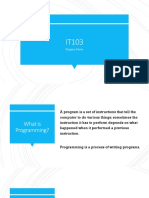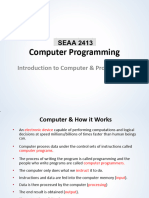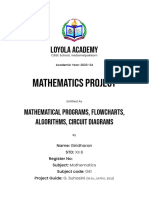0 ratings0% found this document useful (0 votes)
13 viewsUnit I A Programming Fundamentals
- Programming involves writing instructions for a computer to perform tasks. Programming languages make this easier by using English-like commands rather than binary code.
- The program development life cycle involves analyzing the problem, designing a solution algorithm and flowchart, coding the solution in a programming language, testing for errors, and documenting the program.
- Key steps include problem analysis, program design using algorithms and pseudo-code, development by coding the design in a programming language, testing the program, and maintaining it after installation.
Uploaded by
DATU AL-ANSARI UKOCopyright
© © All Rights Reserved
We take content rights seriously. If you suspect this is your content, claim it here.
Available Formats
Download as PDF, TXT or read online on Scribd
0 ratings0% found this document useful (0 votes)
13 viewsUnit I A Programming Fundamentals
- Programming involves writing instructions for a computer to perform tasks. Programming languages make this easier by using English-like commands rather than binary code.
- The program development life cycle involves analyzing the problem, designing a solution algorithm and flowchart, coding the solution in a programming language, testing for errors, and documenting the program.
- Key steps include problem analysis, program design using algorithms and pseudo-code, development by coding the design in a programming language, testing the program, and maintaining it after installation.
Uploaded by
DATU AL-ANSARI UKOCopyright
© © All Rights Reserved
We take content rights seriously. If you suspect this is your content, claim it here.
Available Formats
Download as PDF, TXT or read online on Scribd
You are on page 1/ 4
COMPUTER PROGRAMMING – 1 consists of 0’s and 1’s which
INTRODUCTION makes programming very difficult.
Programming • Assembly Language – uses
• Series of instructions to a ―abbreviation‖ or mnemonics in
computer to accomplish a task. place of binary patterns in order
• Instructions must be written in a to make task of programming
way the computer can easier.
understand • Assembler – is special program
• Programming languages are used that translates assembly language
to write programs instructions into a machine
• Once the code (language) of language instruction.
program has been written, it must
be executed (run, started).
Programming languages
• Set of commands that a
computer has been ―taught‖ to
understand
• Languages that look like
―machine code‖ (e.g 82A8; jsr r5,
@#82AE 82AC: sob ro, 8296) are High level Language
used for Uses English – like commands or
• Writing games instructions, is the easiest to use and
• Writing application contains many complicated or advance
programs (like Excel) instructions, also known as the third
Other languages look like English “high generation language.
level, “e.g, PRINT “HELLO”) Compiler
• Logo Is a special program that translates high
• JavaScript – level languages instruction into a
Examples of an instruction to print the machine language instruction.
word “HI” Fourth Generation Language
• Logo - PR [HI] A programming language designed with
• JavaScript - alert(“HI”) a specific purpose in mind such as the
• FORTRAN - PRINT “HI” development of commercial business
• BASIC - PRINT “HI” software.
• COBOL - DISPLAY “HI”
• C++ - printf(“HI”);
• Pascal - WRITELN(“HI”)
• Assembly - XPRINT
MESSAGE1
Types of programming languages
• Machine Language – is a natural
or primitive language that the
computer actually understand,
PROGRAMMING FUNDAMENTAL - An algorithm is written, which is an
- Computer is an electronic device English-like explanation of the
solution.
that accepts data, processes it,
- A flowchart is drawn, which is a
and generates the relevant diagrammatic representation of
output. It can perform both simple the solution. The
solution is represented
and complex tasks with very high
diagrammatically, for easy
speed and accuracy. understanding and clarity.
However, a computer cannot - A pseudo code is written for the
selected solution. Pseudo code
perform any task—simple or
uses the structured
complex, of its own programming constructs. The
- Computers need to be instructed pseudo code becomes an input
about ―how‖ the task is to be to the next phase.
3. Program Development
performed. The set of instructions - The computer programming
that instruct the computer about languages are of different kinds—
the way the task is to be low-level languages,
and high-level languages like C,
performed is called a program. A
C++ and Java. The pseudo code
program is required for processing is coded using a
all kind of tasks—simple tasks like suitable programming language.
- The coded pseudo code or
addition of two numbers, and
program is compiled for any
complex tasks like gaming etc. syntax errors. Syntax
errors arise due to the incorrect
use of programming language or
PROGRAM DEVELOPMENT LIFE CYCLE
due to the grammatical errors
Three essential parts: with respect to the programming
1. Instructions to accept the input language used. During
data that needs to be processed, compilation, the syntax errors, if
any, are removed.
2. Instructions that will act upon the
- The successfully compiled
input data and process it, and program is now ready for
3. Instructions to provide the output execution.
- The executed program generates
to user.
the output result, which may be
A person who writes the program correct or incorrect. The program
(computer programmer) has to follow is tested with various inputs, to see
that it generates the desired
the Program Development Life Cycle.
results. If incorrect results are
displayed, then the program has
1. Problem Analysis—The semantic error (logical
programmer first understands the error). The semantic errors are
problem to be solved. The removed from the program to get
programmer determines the the correct results.
various ways in which the problem - The successfully tested program is
can be solved, and decides upon ready for use and is installed on
a single solution which will be the user’s
followed to solve the problem. machine.
2. Program Design—The selected 4. Program Documentation and
solution is represented in a form, Maintenance—The program is
so that it can be coded. properly documented,
so that later on, anyone can use it
This requires three steps: and understand its working. Any
changes made to
the program, after installation,
forms part of the maintenance of
Both the algorithms accomplish the
program. The program
same goal, but in different ways. The
may require updating, fixing of
programmer selects the algorithm
errors etc. during the based on the advantages and
maintenance phase. disadvantages of each algorithm. For
example, the first algorithm has more
SUMMARISES THE STEPS OF THE PROGRAM
number of comparisons, whereas in
DEVELOPMENT CYCLE the second algorithm
an additional variable MAX is
required.
Example2: Write an algorithm that
reads two values, determines the
largest value and prints the largest
value with an identifying message.
ALGORITHM
- Algorithm is an ordered sequence CONTROL STRUCTURES
of finite, well defined,
unambiguous instructions for o specify the statements to
completing a task. Algorithm is an be executed and the order
English-like representation of the of execution of statements.
logic which is used to solve o There are three kinds
the problem. of control structures:
- It is a step-by-step procedure for a) Sequential—instructions
solving a task or a problem. The are executed in linear
steps must be order
ordered, unambiguous and finite b) Selection (branch or
in number. conditional)—it asks a
true/false question and
Example1: Algorithm to find the greatest then selects the next
among three numbers. instruction based on the
answer
Algorithm 1
c) Iterative (loop)—it
Step 1: Start
repeats the execution
Step 2: Read the three numbers
of a block of instructions
A, B, C
Step 3: Compare A and B. If A is FLOWCHART
greater perform step 4 else
perform step 5. o A diagrammatic
Step 4: Compare A and C. If A is representation of the logic
greater, output “A is greatest” else for solving a task. A
output “C is greatest”. flowchart is
Perform step 6. drawn using boxes of
Step 5: Compare B and C. If B is different shapes with lines
greater, output “B is greatest” else connecting them to show
output “C is greatest”. the flow of control
Step 6: Stop
Preparing a Flowchart
o A flowchart may be simple
or complex. The most
common symbols that are
used to draw a flowchart
are—Process, Decision, Example4: Find the profit/loss
Data, Terminator, when income = 1000 and cost =
Connector and Flow lines. 800
o While drawing a flowchart,
some rules need to be
followed. A flowchart
should have a start and
end.
PSEUDO CODE
o Pseudo code consists of
short, readable and
formally-styled English
language used for
explaining an algorithm.
o Pseudo code does not
include details like variable
declarations, subroutines
etc.
o Pseudo code is a short-
hand way of describing a
computer program.
Example3: Find the sum of 529 and 256
Example5: Find the maximum of
any three numbers.
You might also like
- ISO DIS 10009 (En) - Quality Management - Guidance For Quality Tools and Their Application100% (4)ISO DIS 10009 (En) - Quality Management - Guidance For Quality Tools and Their Application55 pages
- Uct Business Systems Analysis Course Information PackNo ratings yetUct Business Systems Analysis Course Information Pack6 pages
- 01 Topic 1 - Introduction To Computer Programming - RemovedNo ratings yet01 Topic 1 - Introduction To Computer Programming - Removed29 pages
- APznzaan_OyAH4nnNVM2ehVv11_rq5yt5KN4a5Pt8b2fCa-j-a-nLaL-P9ZzvwTI0HQa36mBDm8gt6ugh9j00BqR5MMI0d74wUgNrHvqCfSepprS4CG0MXWagHXYttdmtmSXgstn4KsFIRYU-t9iKMSWinHVp8jByKasCmPBCwU4kkzUL890EfgJjDJLrWa7qkyfKAbBYiLhNo ratings yetAPznzaan_OyAH4nnNVM2ehVv11_rq5yt5KN4a5Pt8b2fCa-j-a-nLaL-P9ZzvwTI0HQa36mBDm8gt6ugh9j00BqR5MMI0d74wUgNrHvqCfSepprS4CG0MXWagHXYttdmtmSXgstn4KsFIRYU-t9iKMSWinHVp8jByKasCmPBCwU4kkzUL890EfgJjDJLrWa7qkyfKAbBYiLh32 pages
- ARE - 510 - 6 - Programming and LanguagesNo ratings yetARE - 510 - 6 - Programming and Languages38 pages
- Programming IN C: Introduction To Computer ProgrammingNo ratings yetProgramming IN C: Introduction To Computer Programming43 pages
- IT - Som Værktøj: Bent Thomsen Institut For Datalogi Aalborg UniversitetNo ratings yetIT - Som Værktøj: Bent Thomsen Institut For Datalogi Aalborg Universitet46 pages
- Chapter 1: Fundamental of Computer Problem Solving100% (1)Chapter 1: Fundamental of Computer Problem Solving18 pages
- (M2-MAIN) Introduction To Computer and Programming ConceptsNo ratings yet(M2-MAIN) Introduction To Computer and Programming Concepts50 pages
- 1b) SMA 2175 Introduction To Programming in C Notes - 1-3No ratings yet1b) SMA 2175 Introduction To Programming in C Notes - 1-326 pages
- Introduction To Program Logic FormulationNo ratings yetIntroduction To Program Logic Formulation29 pages
- Topic 2 - Algorithmic Problem Solving PDFNo ratings yetTopic 2 - Algorithmic Problem Solving PDF63 pages
- Chapter 1 Basic Concepts and Logic DesignNo ratings yetChapter 1 Basic Concepts and Logic Design16 pages
- Programming: Lesson 1. Course Overview. Introduction To ProgrammingNo ratings yetProgramming: Lesson 1. Course Overview. Introduction To Programming55 pages
- COMPUTER PROGRAMMING FOR KIDS: An Easy Step-by-Step Guide For Young Programmers To Learn Coding Skills (2022 Crash Course for Newbies)From EverandCOMPUTER PROGRAMMING FOR KIDS: An Easy Step-by-Step Guide For Young Programmers To Learn Coding Skills (2022 Crash Course for Newbies)No ratings yet
- 09 Jedi Intro To Programming Student ManualNo ratings yet09 Jedi Intro To Programming Student Manual241 pages
- KASAI North America 1000-08416-14 Supplier Quality ManualNo ratings yetKASAI North America 1000-08416-14 Supplier Quality Manual56 pages
- Lesson 3 - Program Development Life CycleNo ratings yetLesson 3 - Program Development Life Cycle6 pages
- 3.3.1-3.3.6 - Onboarding - REVIEWED - Q1 19No ratings yet3.3.1-3.3.6 - Onboarding - REVIEWED - Q1 197 pages
- Chapter 2: Introduction To Transaction ProcessingNo ratings yetChapter 2: Introduction To Transaction Processing69 pages
- Btech Sem 1 2 Btps 101 18 Programming for Problem SolvinggNo ratings yetBtech Sem 1 2 Btps 101 18 Programming for Problem Solvingg2 pages
- Ieltsxpress Makkar Academic Graph Writing PDFNo ratings yetIeltsxpress Makkar Academic Graph Writing PDF195 pages
- Castro, Mae Lalaine B. (Chapter 2 Assignment)No ratings yetCastro, Mae Lalaine B. (Chapter 2 Assignment)3 pages
- Seven Quality Tools: Presented By: M. AschnerNo ratings yetSeven Quality Tools: Presented By: M. Aschner39 pages
- ADET201-Application Development and Emerging Technologies100% (5)ADET201-Application Development and Emerging Technologies50 pages
- C Programming Lecture Notes (Unit-1,2,3)No ratings yetC Programming Lecture Notes (Unit-1,2,3)148 pages
- Next Steps Scheme of Work Unit 4282 Exploring Programming - For Assessment From January 2019No ratings yetNext Steps Scheme of Work Unit 4282 Exploring Programming - For Assessment From January 201922 pages
- Unified Modeling Language (UML) - Activity Diagrams: Difference Between An Activity Diagram and A FlowchartNo ratings yetUnified Modeling Language (UML) - Activity Diagrams: Difference Between An Activity Diagram and A Flowchart1 page





























































































